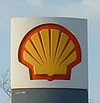 View of the Distillation of crude oil unit (now defunct) from the Sherbrooke East street | |
| Country | Canada |
|---|---|
| Province | Quebec |
| City | Montreal East |
| Coordinates | 45°37′31″N 73°31′49″W / 45.62528°N 73.53028°W |
| Refinery details | |
| Operator | Shell Canada (Soon Delek US) |
| Owner(s) | Shell Canada (Soon Delek US) |
| Commissioned | 1933 |
| Capacity | 161,000 bbl/d (25,600 m3/d) |
| No. of employees | 100 |
| Refining units | alkylation, isomerisation, distillation of crude oil, hydrocracking, reforming catalytic, cracking catalytic, thermal catalytic, desulphuration |
| No. of oil tanks | 154 (discontinued use) |
| Oil refining center | Montreal |
The Montreal East Refinery (French: Raffinerie de Montréal-Est) was an oil refinery located in Montreal East and formerly Shell Canada's largest refinery. In October 2010, refinery operations permanently ceased and the facility was subsequently converted into a storage terminal.[1]
YouTube Encyclopedic
-
1/1Views:7 421
-
A History of Toronto #17: Reclaiming the Waterfront
Transcription
History
The defunct refinery, the second owned by Shell in Canada, opened on 24 March 1933. It began with three units; the distillation unit, a topping unit, and cracking catalytic unit. In 1947 it was expanded with the building of the alkylation and catalytic cracking refining units, and the refining capacity of was increased. From 1947 to 1960, the isomerisation, catalytic reforming, chemicals plants were built and the refining capacity was further increased. During 2002 to 2008, desulphuration units were built and the refining capacity was upgraded to its highest level 161,000 barrels per day (25,600 m3/d).
| Year | Capacity (barrels per day) |
|---|---|
| 1933 | 5,000 |
| 1947 | 40,000 |
| 1951 | 55,000 |
| 1956 | 75,000 |
| 1965 | 124,000 |
| 2003 | 129,000 |
| 2005 | 133,000 |
| 2007 | 161,000 |
On January 7, 2010 Shell Canada announced closing the refinery and converting it to a fuel terminal.[2] On June 4, 2010, following the unsuccessful attempts to find a buyer to take over the plant, Shell Canada announced its plans to move forward to downgrade the refinery into a terminal.[3] The conversion commenced in September 2010, with it permanently ceasing operations as a refinery in October 2010. Approximately 800 jobs were lost.[4]
Description
The refinery consisted of two refining units with capacities of 103,000 barrels per day (16,400 m3/d) and 58,000 barrels per day (9,200 m3/d). It had alkylation, hydro-cracking, reforming catalytic, cracking catalytic, thermal catalytic, isomerisation, and desulphiration units. Its processing capacities included:
- 14,610 barrels per day (2,323 m3/d) of visbreaking
- 27,900 barrels per day (4,440 m3/d) of fluid catalytic cracking
- 20,910 barrels per day (3,324 m3/d) of semi-regenerative catalytic reforming
- 14,100 barrels per day (2,240 m3/d) of hydrocracking for distillate upgrading
- 49,500 barrels per day (7,870 m3/d) of catalytic hydrotreating for cat reformer feeds
- 27,000 barrels per day (4,300 m3/d) of hydrotreating for kerosene/jet desulfurization
- 2,700 barrels per day (430 m3/d) of API Group I base oil
- 1,300 barrels per day (210 m3/d) of unfinished wax.[5] The refinery had 154 oil tanks and more than 450 workers.[2]
After its conversion to a storage terminal, the facility receives gasoline, diesel and aviation fuels for distribution.[2]
See also
- Montreal Refinery
- Montreal East Refinery (Gulf Oil Canada)
- Montreal Oil Refining Center
- Scotford Refinery
- Corunna Refinery
- Nanticoke Refinery
References
- ^ Vanderklippe, Nathan (8 January 2010). "Montreal refinery victim of slow demand". The Globe and Mail. Retrieved 18 January 2016.
- ^ a b c Edward Welsch (7 January 2010). "Shell To Convert Montreal East Refinery Into Fuel Terminal". Dow Jones Newswires. The Wall Street Journal. Retrieved 24 January 2010.[dead link]
- ^ "Shell reaches decision on Montreal East Refinery - Canada". Archived from the original on 2010-06-13. Retrieved 2010-06-14.
- ^ "Shell receives government approval to dismantle Montreal East refinery". CTV News Montreal. 27 June 2011. Retrieved 18 January 2016.
- ^ "Shell Canada to shut Montreal refinery". Oil & Gas Journal (requires subscription). PennWell Corporation. 14 January 2010. Retrieved 24 January 2010.


